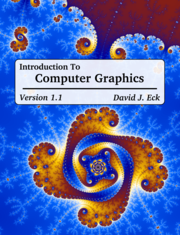
Introduction to Computer Graphics, Version 1.1
A free, on-line textbook covering the fundamentals of computer graphics and computer graphics programming.
Tag(s): Computer Vision
Publication date: 01 Jan 2016
ISBN-10: n/a
ISBN-13: n/a
Paperback: 432 pages
Views: 12,258
Type: Textbook
Publisher: n/a
License: Creative Commons Attribution-NonCommercial-ShareAlike 4.0 International
Post time: 16 Mar 2016 08:00:00
Introduction to Computer Graphics, Version 1.1
 A free, on-line textbook covering the fundamentals of computer graphics and computer graphics programming.
A free, on-line textbook covering the fundamentals of computer graphics and computer graphics programming.
Publication date: 01 Jan 2016
ISBN-10: n/a
ISBN-13: n/a
Paperback: 432 pages
Views: 12,258
Document Type: Textbook
Publisher: n/a
License: Creative Commons Attribution-NonCommercial-ShareAlike 4.0 International
Post time: 16 Mar 2016 08:00:00
Share — copy and redistribute the material in any medium or format
Adapt — remix, transform, and build upon the material
The licensor cannot revoke these freedoms as long as you follow the license terms.
Click here to read the full license.
David J. Eck wrote:This textbook represents my attempt to develop a modern, one-semester first course in computer graphics, which would typically be taken by a computer science student in the third or fourth year of college. A reader should have substantial experience with at least one programming language, including some knowledge of object-oriented programming and data structures. Everyone taking the course at my college will have had at least two semesters of programming, and most will have additional experience beyond that. Students here have studied the Java programming language, but the book should also be accessible to people with background in other languages. Examples in the book use Java, C, and JavaScript. The essential features of those languages are covered in an appendix.
David J. Eck wrote:I have taught computer graphics every couple of years or so for almost 30 years. As the field developed, I had to make major changes almost every time I taught the course, but for much of that time, I was able to structure the course primarily around OpenGL 1.1, a graphics API that was in common use for an extended period. OpenGL 1.1 supported fundamental graphics concepts in a way that was fairly easy to use. OpenGL is still widely supported, but, for various reasons, the parts of it that were easy to use have been officially dropped from the latest versions (although they are in practice supported on most desktop computers). The result is a much more powerful API but one that is much harder to learn. In particular, modern OpenGL in its pure form does not make for a good introduction to graphics programming.
My approach in this book is to use a subset of OpenGL 1.1 to introduce the fundamental concepts of three-dimensional graphics. I then go on to cover WebGL—a version of OpenGL that runs in a web browser—as an example of the more modern approach to computer graphics. While OpenGL makes up the major foundation for the course, the real emphasis is on fundamental concepts such as geometric modeling and transformations; hierarchical modeling and scene graphs; color, lighting, and textures; and animation.
Tweet
About The Author(s)
David J. Eck is a professor in the Department of Mathematics and Computer Science at Hobart and William Smith Colleges. He earned his Ph.D. in Mathematics from Brandeis University in 1980.

David J. Eck is a professor in the Department of Mathematics and Computer Science at Hobart and William Smith Colleges. He earned his Ph.D. in Mathematics from Brandeis University in 1980.